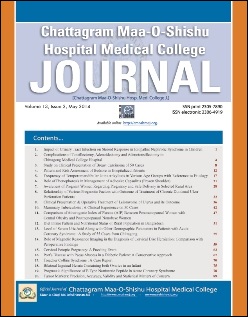Pattern and Risk Assessment of Bedsore in Hospitalized Patients
DOI:
https://doi.org/10.3329/cmoshmcj.v13i2.21049Keywords:
Pneumatic bed, risk factors, spinal cord injury, strokeAbstract
Objective: This descriptive type of cross sectional study was conducted to assess pattern and risk factors of bedsore in hospital admitted patients in Dhaka city with a sample size of 114.
Methods: A pretested, modified, questionnaire was used to collect the data. All the data were entered and analyzed by using Statistical Package of Social Science 16.0 versions.
Results: Study found that 17.5%, 41.2%, 27.2% and 14% of the respondents belonged to age group of 1-20 years, 21-40 years, 41-60 years and 61-80 years respectively with mean age 37.97 +16.909 years. Responsible diseases for bedsore were spinal cord injury (41.2%), fracture (30%), stroke (24%), unconsciousness (7.2%) and GBS (2.8%) respectively. Study revealed that common area of bedsore were back of the sacrum (57%), back of the scapula (34.2%), medial aspect of knee joint (22.8%), malleoli (21.1%), greater trochanter of femur (15.8%), external occipital protuberance (14%), olecranon process of ulna (9.6%), above the coccyx (9.6%), iliac crest (7%), spine of the scapula (3.5%), posterior superior iliac joint (2.6%) and sacro-iliac joint (1.8%) respectively. Study also found that superficial and deep type of bedsore were 58.8% and 41.2% consecutively. Besides study revealed that 26.3% of the respondents were diabetic, 31.6% obese, 28.1% suffering from malnutrition, 61.4% did not use pneumatic bed and 7.2% patients did not maintain proper positioning 2 hourly and these were the risk factors of this study. Significant association was found between type of bed sore and use of pneumatic bed (P=0.000<0.05) as well as nutritional status (P=0.004<0.05).
Conclusions: Changing position and use of pneumatic bed was best methods of prevention of bedsore.
Downloads
495
326
Downloads
Published
How to Cite
Issue
Section
License
Authors of articles published in CMOSHMC Journal retain the copyright of their articles and are free to reproduce and disseminate their work.
A Copyright and License Agreement -signed and dated by the corresponding author on behalf of all authors -must be submitted with each manuscript submission.

